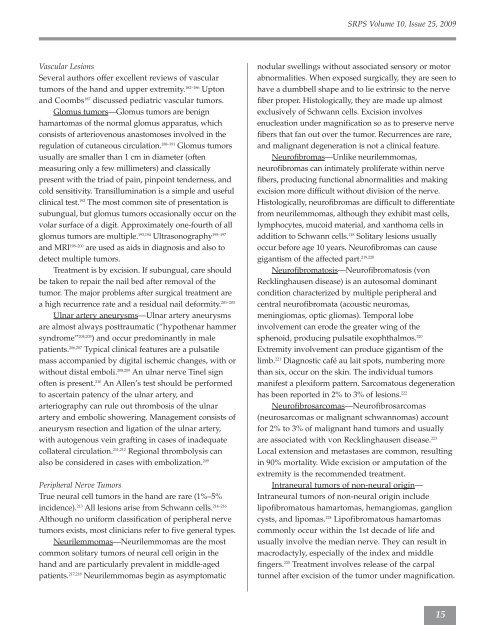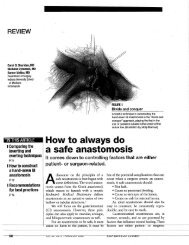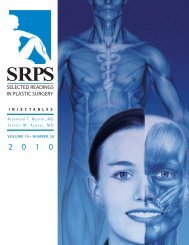SRPS PS - Plastic Surgery Internal
SRPS PS - Plastic Surgery Internal
SRPS PS - Plastic Surgery Internal
You also want an ePaper? Increase the reach of your titles
YUMPU automatically turns print PDFs into web optimized ePapers that Google loves.
Vascular Lesions<br />
Several authors offer excellent reviews of vascular<br />
tumors of the hand and upper extremity. 182–186 Upton<br />
and Coombs 187 discussed pediatric vascular tumors.<br />
Glomus tumors—Glomus tumors are benign<br />
hamartomas of the normal glomus apparatus, which<br />
consists of arteriovenous anastomoses involved in the<br />
regulation of cutaneous circulation. 188–191 Glomus tumors<br />
usually are smaller than 1 cm in diameter (often<br />
measuring only a few millimeters) and classically<br />
present with the triad of pain, pinpoint tenderness, and<br />
cold sensitivity. Transillumination is a simple and useful<br />
clinical test. 192 The most common site of presentation is<br />
subungual, but glomus tumors occasionally occur on the<br />
volar surface of a digit. Approximately one-fourth of all<br />
glomus tumors are multiple. 193,194 Ultrasonography 195–197<br />
and MRI 198–200 are used as aids in diagnosis and also to<br />
detect multiple tumors.<br />
Treatment is by excision. If subungual, care should<br />
be taken to repair the nail bed after removal of the<br />
tumor. The major problems after surgical treatment are<br />
a high recurrence rate and a residual nail deformity. 201–203<br />
Ulnar artery aneurysms—Ulnar artery aneurysms<br />
are almost always posttraumatic (“hypothenar hammer<br />
syndrome” 204,205 ) and occur predominantly in male<br />
patients. 206,207 Typical clinical features are a pulsatile<br />
mass accompanied by digital ischemic changes, with or<br />
without distal emboli. 208,209 An ulnar nerve Tinel sign<br />
often is present. 210 An Allen’s test should be performed<br />
to ascertain patency of the ulnar artery, and<br />
arteriography can rule out thrombosis of the ulnar<br />
artery and embolic showering. Management consists of<br />
aneurysm resection and ligation of the ulnar artery,<br />
with autogenous vein grafting in cases of inadequate<br />
collateral circulation. 211,212 Regional thrombolysis can<br />
also be considered in cases with embolization. 209<br />
Peripheral Nerve Tumors<br />
True neural cell tumors in the hand are rare (1%–5%<br />
incidence). 213 All lesions arise from Schwann cells. 214–216<br />
Although no uniform classification of peripheral nerve<br />
tumors exists, most clinicians refer to five general types.<br />
Neurilemmomas—Neurilemmomas are the most<br />
common solitary tumors of neural cell origin in the<br />
hand and are particularly prevalent in middle-aged<br />
patients. 217,218 Neurilemmomas begin as asymptomatic<br />
<strong>SR<strong>PS</strong></strong> Volume 10, Issue 25, 2009<br />
nodular swellings without associated sensory or motor<br />
abnormalities. When exposed surgically, they are seen to<br />
have a dumbbell shape and to lie extrinsic to the nerve<br />
fiber proper. Histologically, they are made up almost<br />
exclusively of Schwann cells. Excision involves<br />
enucleation under magnification so as to preserve nerve<br />
fibers that fan out over the tumor. Recurrences are rare,<br />
and malignant degeneration is not a clinical feature.<br />
Neurofibromas—Unlike neurilemmomas,<br />
neurofibromas can intimately proliferate within nerve<br />
fibers, producing functional abnormalities and making<br />
excision more difficult without division of the nerve.<br />
Histologically, neurofibromas are difficult to differentiate<br />
from neurilemmomas, although they exhibit mast cells,<br />
lymphocytes, mucoid material, and xanthoma cells in<br />
addition to Schwann cells. 218 Solitary lesions usually<br />
occur before age 10 years. Neurofibromas can cause<br />
gigantism of the affected part. 219,220<br />
Neurofibromatosis—Neurofibromatosis (von<br />
Recklinghausen disease) is an autosomal dominant<br />
condition characterized by multiple peripheral and<br />
central neurofibromata (acoustic neuromas,<br />
meningiomas, optic gliomas). Temporal lobe<br />
involvement can erode the greater wing of the<br />
sphenoid, producing pulsatile exophthalmos. 220<br />
Extremity involvement can produce gigantism of the<br />
limb. 221 Diagnostic café au lait spots, numbering more<br />
than six, occur on the skin. The individual tumors<br />
manifest a plexiform pattern. Sarcomatous degeneration<br />
has been reported in 2% to 3% of lesions. 222<br />
Neurofibrosarcomas—Neurofibrosarcomas<br />
(neurosarcomas or malignant schwannomas) account<br />
for 2% to 3% of malignant hand tumors and usually<br />
are associated with von Recklinghausen disease. 223<br />
Local extension and metastases are common, resulting<br />
in 90% mortality. Wide excision or amputation of the<br />
extremity is the recommended treatment.<br />
Intraneural tumors of non-neural origin—<br />
Intraneural tumors of non-neural origin include<br />
lipofibromatous hamartomas, hemangiomas, ganglion<br />
cysts, and lipomas. 224 Lipofibromatous hamartomas<br />
commonly occur within the 1st decade of life and<br />
usually involve the median nerve. They can result in<br />
macrodactyly, especially of the index and middle<br />
fingers. 225 Treatment involves release of the carpal<br />
tunnel after excision of the tumor under magnification.<br />
15






